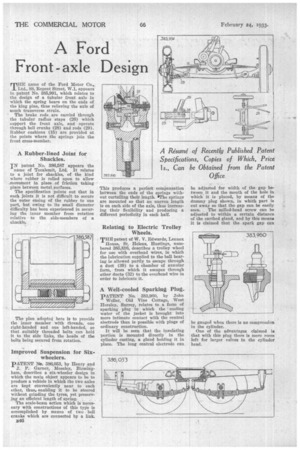A Ford Front -axle Design
Page 60

If you've noticed an error in this article please click here to report it so we can fix it.
THE name of the Ford Motor Co., Ltd., 88, Regent Street, W.1, appears in patent No. 385,991, which relates to the design of a tubular front axle inwhich the spring bears on the ends of the king pins, thus relieving the axle of much transverse strain.
The brake rods are carried through the tubular radius stays (26) which support the front axle, and operate through bell cranks (28) and rods (29). Rubber cushions (15) are provided at the points where the springs join the front cross-member.
A Rubber-lined Joint for Shackles.
IN patent No. 386,587 appears the name of Tecalemit, Ltd. It relates to a joint for shackles, of the kind where rubber is relied upon to allow movement in place of friction taking place between metal surfaces.
The specification points out that in such joints it is not difficult to secure the outer casing of the rubber to one part, but owing to its small diameter difficulty has been experienced in securing the inner member from rotation relative to the side-members of a shackle.
Improved Suspension for Sixwheelers.
pATENT No. 386,053, by Henry and
3. P. Garner, Moseley, Birmingham, describes a six-wheeler design in which the main object appears to be to produce a vehicle in which the two axles are kept conveniently near to each other, thus, enabling it to be steered without grinding the tyres, yet preserving an efficient length of spring.
The scale-beam action which is necessary with constructions of this type is accomplished by means of two bell cranks which are connected by a link.
This produces a perfect compensation between the ends of the springs without curtailing their length. The springs are mounted so that an uneven length is on each side of the axle, thus increasing their flexibility and producing a different periodicity in each half.
Relating to Electric Trolley . Wheels.
THE patent of W. V, Edwards, Lennox Rouse, St. Helens, Hastings, numbered 385,816, describes a trolley wheel for use with overhead wires, in which the lubrication supplied to the ball bearing is allowed partly to escape through a duct (39) to a chamber of annular form, from which it escapes through other ducts (32) to the overhead wire in order to lubricate it.
A Well-cooled Sparking Plug. pATENT No. 383,960, by John Weller, Old Vine Cottage, West Horsley, Surrey, relates to a form of sparking plug in which the cooling water of the jacket is brought into more intimate contact with the central electrode than is possible with plugs of ordinary construction.
It will be seen that the insulating portion is mounted directly in the cylinder casting, a gland bolding it in place. The long central electrode can
be adjusted for width of the gap between, it and the mouth of the hole in which it is placed, by means of the dummy plug shown, in which part is cut away so that the gap can be easily seen. The milled-head screw can be adjusted to within a certain distance of the earthed gland, and by this meand it is claimed that the spark gap can be gauged when there is no compression in the cylinder.
One of the advantages claimed is that with this plug there is more room left for larger valves in the cylinder head.




























































































